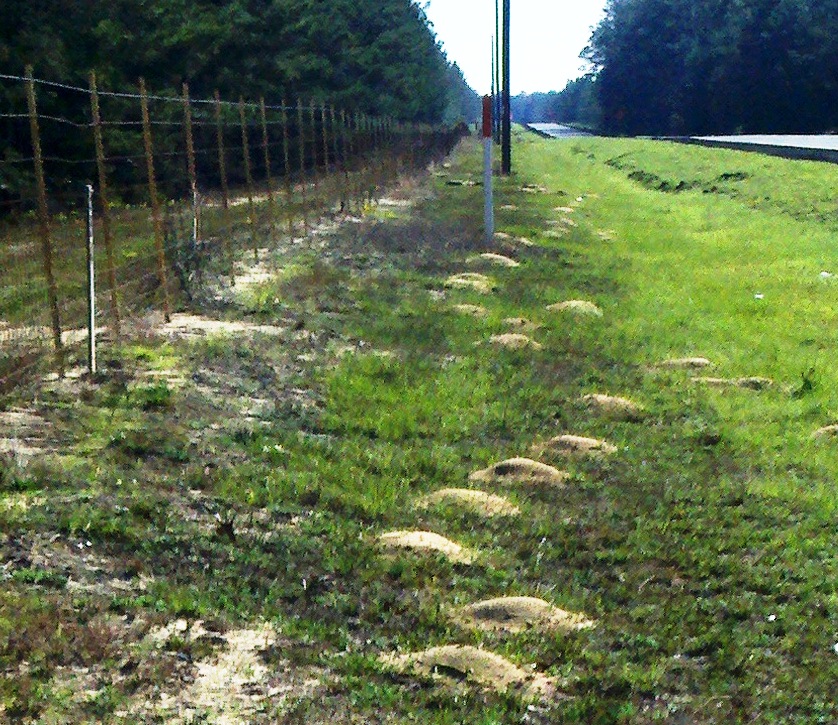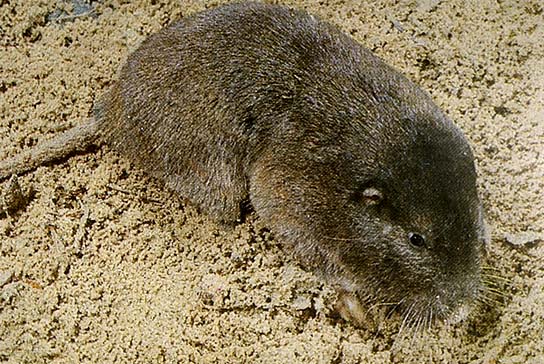
Pocket Gophers push soil to the surface creating these dirt mounds as they dig their underground tunnels.
Have you ever wondered what those mounds of soil are that seem to appear from nowhere in surrounding fields and pastures? They are actually dirt mounds dug by the southeastern pocket gopher. The southeastern pocket gopher, Geomys pinetis, is also known as the “sandy-mounder,” and the name sandy-mounder has evolved into “salamander” in some areas of the Southeastern US, including northwest Florida.
What is a Pocket Gopher?
The pocket gopher is actually a rodent which lives underground in an elaborate tunnel system that it digs and maintains. It has small eyes, small ears, but large claws for digging on its front legs (Figure 1.) The word “Pocket” in Pocket Gopher is referring to its fur-lined cheek pouches that this rodent uses to carry food. Another interesting adaptation of this rodent is that its lips close behind its protruding front teeth. This is so the gopher can chew through soil or roots without getting dirt in its mouth. The average size of an adult gopher is about 10 inches from nose to the tip of its tail.

Figure 1. The Southeastern Pocket Gopher lives in tunnels underground. Image source: http://www.floridiannature.com/rodents(2).htm
Ecology and Management
The following was adapted for this article from the UF/IFAS Publication Southeastern Pocket Gopher, by William H. Kern, Jr. “The southeastern pocket gopher requires deep, well-drained sandy soils. It is most abundant in longleaf pine/turkey oak, sand-hill habitats, but it is also found in coastal strand, sand pine scrub, and upland hammock habitats. Gophers dig extensive tunnel systems and are rarely seen on the surface. The average tunnel length is 145 feet and at least one tunnel was followed for 525 feet! The soil gophers remove while digging their tunnels is pushed to the surface to form those characteristic sand mounds we see in open pastures. Mound building seems to be more intense during the cooler months, especially spring and fall, and slower in the summer. In the spring, pocket gophers push up 1-3 mounds per day. Based on mound construction, gophers seem to be more active at night and around dusk and dawn, but they may be active at any time of day.”
“The primary tunnels run parallel to the surface and most are from 2 inches to 2 feet below the surface. Some tunnels may extend downward as far as 5 feet. Nests and food storage chambers are located in these deeper tunnels. As the gopher digs, it pushes the excavated dirt behind itself. It then turns around in the tunnel and pushes the dirt up a tunnel that ends at the surface, producing a mound. As the main tunnel progresses, a new lateral tunnel is dug to the surface. Then the first tunnel is backfilled to block it off from the surface. This backfill is a defense against the gopher’s main predator, the Florida pine snake…”
“In natural settings, gopher tunneling activities are actually beneficial. The soil gophers bring to the surface contains needed plant nutrients. This natural fertilizer helps to maintain the surrounding ecosystem, and the mounds of loose soil provide ideal germination sites for native plant seeds. Also, many other types of animals use pocket gopher mounds and tunnels as their homes and hideaways.”
“The pocket gopher feeds on the tap roots, crown roots, fleshy rhizomes, bulbs, and tubers of a wide variety of plants in its natural environment. Bahiagrass tubers appear to be a preferred food based on the contents of food caches. Gophers also have an unfortunate fondness for sweet potatoes, peanuts, sugarcane, alfalfa, and peas.”
“The most common problem associated with pocket gophers is the numerous large, sandy mounds they deposit on the surface. Occasionally, gophers will feed on the roots or tubers of garden, ornamental, or crop plants.”
“When pocket gophers are damaging lawns, gardens, or crops, it is legal for the landowner to trap them without a permit. Trapping is the most effective method for controlling those gophers that invade yards, gardens, and crop fields. Gophers should be maintained in natural areas and can usually be tolerated along rights -of-way for road ways and powerlines.”
“If a lawn service or pest control technician is hired to trap nuisance animals that person must have a certified pest control operator’s license in Lawn and Ornamental pest control or some special certification may be required for commercial wildlife control. No poison (bait or fumigant) may be used on native wildlife in Florida, with the following exception effective July 1, 2008. Title 68A -9.010 (2) of the Florida Administrative Code. (2) Methods that may not be used to take nuisance wildlife: (d) Poison, other than those pesticides that are registered by the Florida Department of Agriculture and Consumer Services without additional authorizations and are only used in a manner consistent with the product labeling.”
For more detailed information on the pocket gopher and its management, please see the following University of Florida IFAS publications used for this article:
Ecological Engineers: Southeastern Pocket Gophers Are One of Nature’s Architects
- Maintaining Dissolved Oxygen Levels in Your Pond to Reduce Fish Kills - September 21, 2018
- The Bumble Bee – One of Florida’s Vital Pollinators - September 14, 2018
- 2017-2018 Bee Informed Partnership’s National Bee Colony Loss Report - July 13, 2018
